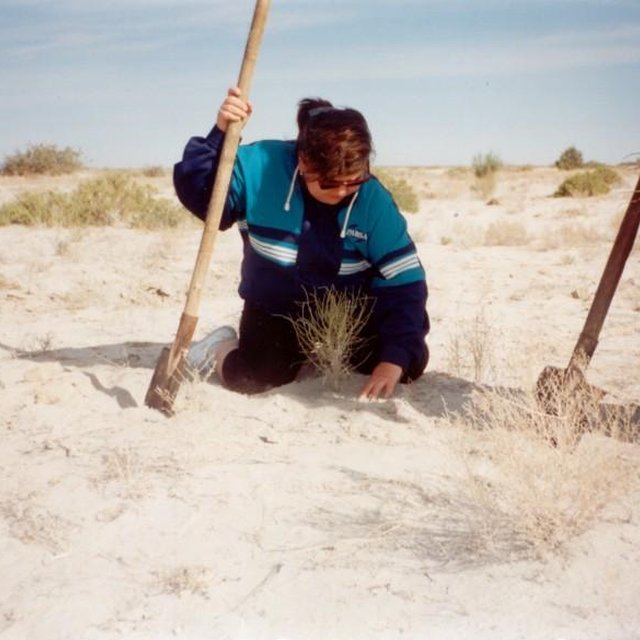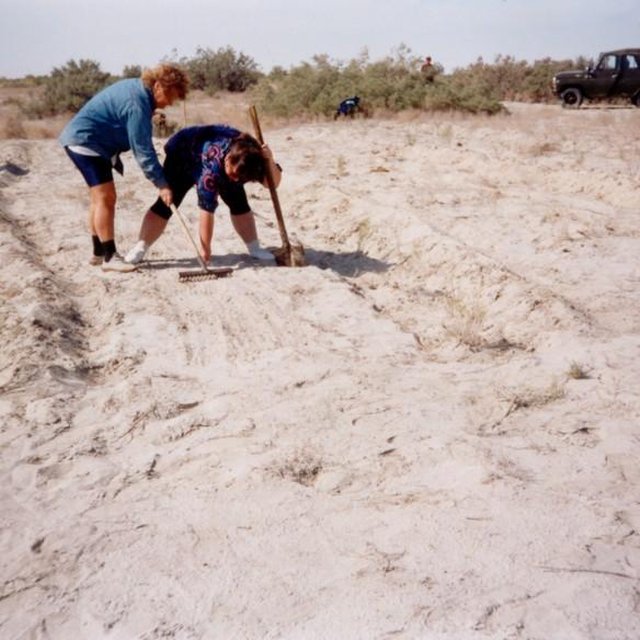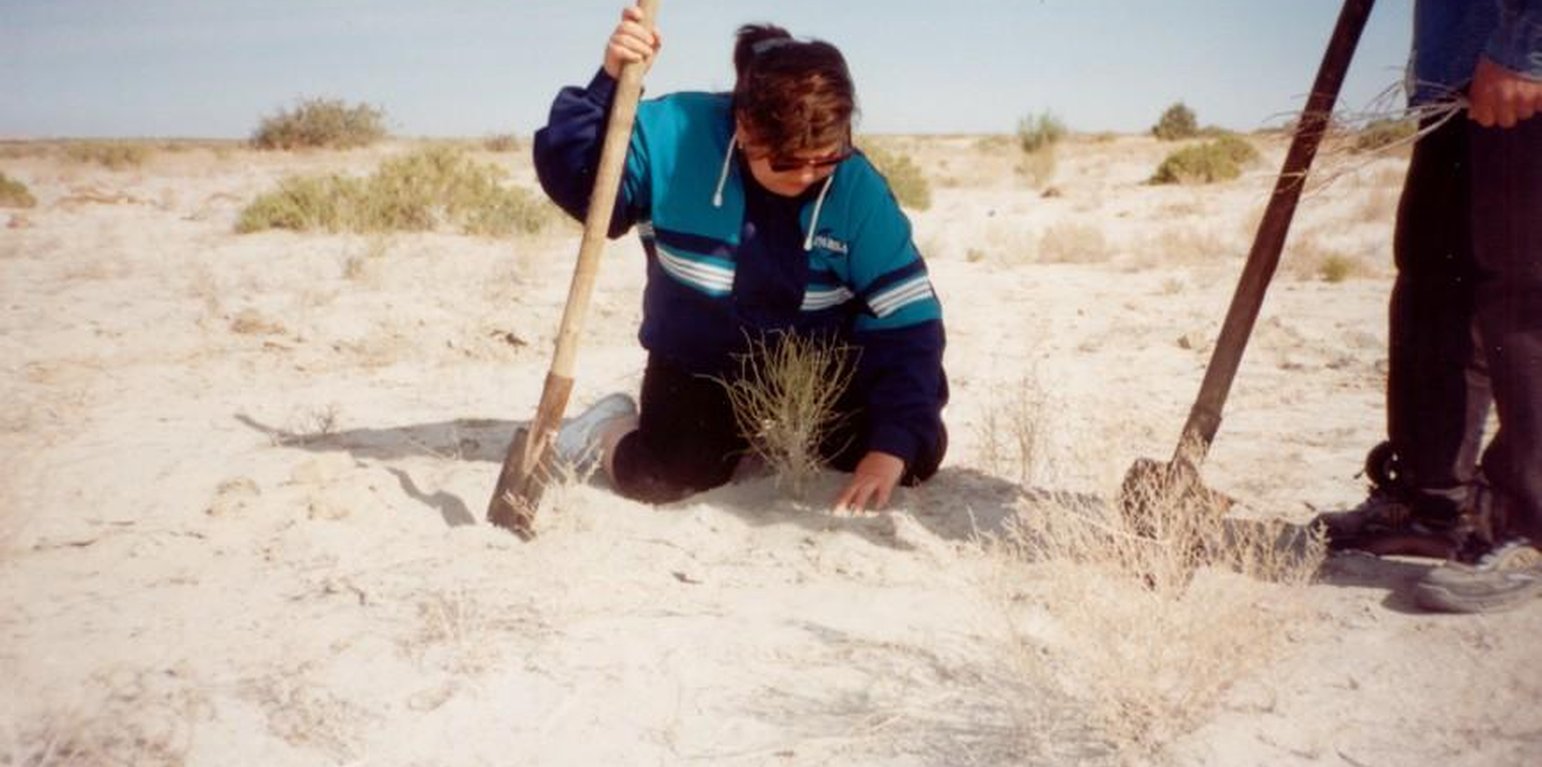Principle of the excavated disposition of phytomeliorants on a pasturable lands of desert zone
(Kazakhstan)
Description
Principle of the excavated disposition of phytomeliorants on a pasturable lands of deserted zone of the Kazakhstan with the purpose of accumulation of an additional moisture and protection of territory against wind erosion
Aims / objectives: Principle of the excavated disposition of phytomeliorants on a pasturable lands of deserted zone of the Kazakhstan with the purpose of accumulation of an additional moisture and protection of territory against wind erosion. 1) The purpose of the given approach is to keep the pasturable lands of the arid zone to save up an additional moisture and to protect pastures against wind erosion. 2) The excavated disposition of phytomeliorants (saxaul, calligonum) should be applied on degradative sites of pastures. The given approach allows to create additional humidifying of the ground that conducts to increasing of the period of grassy vegetation and enrichment of its specific structure. For planting are used one and two years nurseling. Planting of nurselings are carrying out in the early spring on depth of 35-40 cent. into strip lines. There are created two three rowed strips. The distance between strips and plants of three meters. After planting once watering. Before planting strip lines are creating in manual or by machine LPA -1. Many farmers of the southern Pribalhashya uses the given approach on the pastures for prevention against wind erosion.
Location
![]()
Location: Almatynscaya oblast, Kazakhstan
Geo-reference of selected sites
Initiation date: 1976
Year of termination: 1979
Type of Approach
-
traditional/ indigenous
-
recent local initiative/ innovative
-
project/ programme based

Planting of seedlings of saxaul on furrow.

Planting of seedlings of saxaul on furrow.
Approach aims and enabling environment
Main aims / objectives of the approach
The Approach focused on SLM only (Structure of ground, stocks of a moisture, efficiency of pasture)
Preservation of productive longevity of pastures
The SLM Approach addressed the following problems: Decrease in the centers of erosion on the pastures. Accumulation of moisture on the pasturable grounds.
Conditions enabling the implementation of the Technology/ ies applied under the Approach
Conditions hindering the implementation of the Technology/ ies applied under the Approach
-
Legal framework (land tenure, land and water use rights): Absence of legistative base on use of the land
Treatment through the SLM Approach: Acceptance of the low ' the land code of the Republic of Kazakhstan'
The existing land ownership, land use rights / water rights greatly hindered the approach implementation The land was in hands of the state
Participation and roles of stakeholders involved
Stakeholders involved in the Approach and their roles
| What stakeholders / implementing bodies were involved in the Approach? |
Specify stakeholders |
Describe roles of stakeholders |
| local land users/ local communities |
|
Farmers. Working land users were mainly men. |
| SLM specialists/ agricultural advisers |
|
|
| local government |
|
|
| national government (planners, decision-makers) |
|
|
Involvement of local land users/ local communities in the different phases of the Approach
none
passive
external support
interactive
self-mobilization
initiation/ motivation
workshops/seminars; the information on the project and it's influence on development of the economy
planning
Mainly: rapid/participatory rural appraisal; partly: interviews/questionnaires; data gethering
implementation
casual labour; from among land users
Research
on-farm; on the farmer's pastures
Decision-making on the selection of SLM Technology
Decisions were taken by
-
land users alone (self-initiative)
-
mainly land users, supported by SLM specialists
-
all relevant actors, as part of a participatory approach
-
mainly SLM specialists, following consultation with land users
-
SLM specialists alone
-
politicians/ leaders
Decisions were made based on
-
evaluation of well-documented SLM knowledge (evidence-based decision-making)
-
research findings
-
personal experience and opinions (undocumented)
Technical support, capacity building, and knowledge management
The following activities or services have been part of the approach
-
Capacity building/ training
-
Advisory service
-
Institution strengthening (organizational development)
-
Monitoring and evaluation
-
Research
Capacity building/ training
Training was provided to the following stakeholders
-
land users
-
field staff/ advisers
-
SWC specialists
Form of training
-
on-the-job
-
farmer-to-farmer
-
demonstration areas
-
public meetings
-
courses
Subjects covered
on models of pasture protective strips in the settlement Ajdarly
Advisory service
Advisory service was provided
-
on land users' fields
-
at permanent centres
Advisory service is quite adequate to ensure the continuation of land conservation activities
Institution strengthening
Institutions have been strengthened / established
-
no
-
yes, a little
-
yes, moderately
-
yes, greatly
Describe institution, roles and responsibilities, members, etc.
Type of support
-
financial
-
capacity building/ training
-
equipment
Further details
Monitoring and evaluation
bio-physical aspects were regular monitored through observations
economic / production aspects were regular monitored through measurements
There were no changes in the Approach as a result of monitoring and evaluation
Research
Research treated the following topics
-
sociology
-
economics / marketing
-
ecology
-
technology
The approach provides the decision of same problems which are marked in the column.
Research was carried out both on station and on-farm
Financing and external material support
Annual budget in USD for the SLM component
-
< 2,000
-
2,000-10,000
-
10,000-100,000
-
100,000-1,000,000
-
> 1,000,000
Precise annual budget: n.a.
Approach costs were met by the following donors: government (national): 100.0%
The following services or incentives have been provided to land users
-
Financial/ material support provided to land users
-
Subsidies for specific inputs
-
Credit
-
Other incentives or instruments
Financial/ material support provided to land users
partly financed
fully financed
Labour by land users was
-
voluntary
-
food-for-work
-
paid in cash
-
rewarded with other material support
Impact analysis and concluding statements
Impacts of the Approach
No
Yes, little
Yes, moderately
Yes, greatly
Did the Approach help land users to implement and maintain SLM Technologies?
direct influence - increase in efficiency of pastures
Did the Approach improve issues of land tenure/ user rights that hindered implementation of SLM Technologies?
Did other land users / projects adopt the Approach?
Main motivation of land users to implement SLM
Sustainability of Approach activities
Can the land users sustain what hat been implemented through the Approach (without external support)?
Conclusions and lessons learnt
Strengths: land user's view
Strengths: compiler’s or other key resource person’s view
-
Expansion of an apportunity of using of the poor stocks of a moisture (How to sustain/ enhance this strength: belief of land users in utility of the given approach.)
-
Prevention of deflating processes
Weaknesses/ disadvantages/ risks: land user's viewhow to overcome
Weaknesses/ disadvantages/ risks: compiler’s or other key resource person’s viewhow to overcome
References
Date of documentation: Jan. 20, 2009
Last update: Julie 17, 2017
Resource persons
-
Ilya Allimaev - SLM specialist
Full description in the WOCAT database
Documentation was faciliated by
Key references
-
Pastures and hayland of Kazakhstan Alimaev I. Isakov K. Almaty, 1998: Almaty, free





